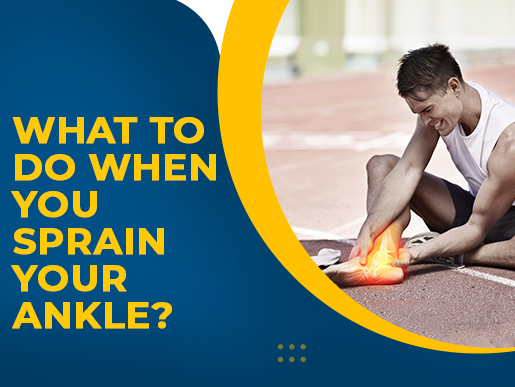All it takes is a simple misstep, and suddenly you have a sprained ankle. An ankle sprain is one of the most common musculoskeletal injuries in people of all ages, athletes, and lazy people alike. The injury occurs when one or more of the ankle ligaments are stretched or torn, causing pain, swelling, and difficulty walking. Many people try to tough out ankle injuries and do not seek medical attention. But if an ankle sprain causes more than slight pain and swelling, it is crucial to see a clinician. Without proper treatment and rehabilitation, a severely injured ankle may not heal well. It could lose its range of motion and stability, resulting in recurrent sprains and more downtime in the future.
Immediate ankle sprain treatment:
The first goal is to decrease pain and swelling and protect the ligaments from further injury. It usually means adopting the classic RICE regimen — rest, ice, compression, and elevation. If you have severe pain and swelling, rest your ankle as much as possible for the first 24–48 hours. During that time, immerse your foot and ankle in cold water, or apply an ice pack (be sure to cover the ankle with a towel to protect the skin) for 15–20 minutes three to five times a day, or until the swelling starts to subside.
To reduce swelling:
- Compress the ankle with an elasticized wrap, such as an ACE bandage or elastic ankle sleeve.
- When seated, elevate your ankle as high as you comfortably can — to the height of your hip, if possible.
- In the first 24 hours, avoid anything that might increase swelling, such as hot showers, hot packs, or heat rubs.
Nonsteroidal anti-inflammatory drugs such as ibuprofen can help reduce pain and swelling and may also speed recovery.
Ankle sprain functional treatment:
To recover from an ankle sprain fully, you will need to restore the normal range of motion to your ankle joint and strengthen its ligaments and supporting muscles. Studies have shown that people return to their normal activities sooner when their treatment emphasizes restoring ankle function — often with the aid of splints, braces, taping, or elastic bandages — rather than immobilization (such as the use of a plaster cast). Called available treatment, this strategy usually involves three phases:
- In the first 24 hours, the RICE regimen reduces pain, swelling, and risk of further injury.
- Range-of-motion and strengthening exercises within 48–72 hours.
- Training to improve endurance and balance once recovery is well underway.
Generally, you can begin range-of-motion and stretching exercises within the first 48 hours and should continue until you are as free of pain as you were before your sprain. Start low-impact exercises. As your sprained ankle improves, you can progress to high-impact workouts. If your symptoms are not better in two to four weeks, you may need to see a physical therapist or another specialist.
|
Exercises to help restore function and prevent injury: Range-of-motion, stretching and strengthening: First 1–2 weeks
|
|
Flexes: Rest the heel of the injured foot on the floor. Pull your toes and foot toward your body as far as possible. Release. Then point them away from the body as far as possible. Release. Repeat as often as possible in the first week.
|
|
Ankle Alphabet: With the heel on the floor, write all the capital letters of the alphabet with your big toe, making the letters as large as you can.
|
|
Press down and Pullback: Loop an elasticized band or tubing around the foot, holding it gently taut (A). Press your toes away and down. Hold it for a few seconds. Repeat 30 times. Tie one end of the band to a table or chair leg (B). Loop the other end around your foot and slowly pull the foot towards you. Hold it for a few seconds. Repeat 30 times.
|
|
Ankle Eversion: Seated on the floor, with an elasticized band or tubing tied around the injured foot and anchored around your uninjured foot, slowly turn the injured foot outward. Repeat 30 times.
|
|
Ankle Inversion: Seated on the floor, cross your legs with your injured foot underneath. With an elasticized band or tubing around the injured foot and anchored around your uninjured foot, slowly turn the injured foot inward. Repeat 30 times. Stretching and strengthening: Weeks 3–4
|
|
Stand and Stretch: Stand one arm’s length from the wall. Place the injured foot behind the other foot, toes facing forward. Keep your heels down and the back knee straight. Slowly bend the front knee until you feel the calf stretch in the back leg. Hold for 15–20 seconds. Repeat 3–5 times.
|
|
Seated Stretch: Loop an elasticized band or tubing around the ball of the foot. Keeping the knee straight, slowly pull back on the band until you feel the upper calf stretch. Hold for 15 seconds. Repeat 15–20 times.
|
|
Rises: Stand facing a wall with your hands on the wall for balance. Rise on your toes. Hold for 1 second, then lower yourself slowly to the starting position. Repeat 20–30 times. As you become stronger, do this exercise keeping your weight on just the injured side as you lower yourself down.
|
|
Stretches: Stand on toes and the ball of the affected foot on a book or the edge of a stair. Your heel should be off the ground. Use a wall, chair, or rail for balance. Hold your other foot off the floor behind you, with your knee slightly bent. Slowly lower the heel. Hold the position for 1 second. Return to the starting position. Repeat up to 15 times, several times a day. This exercise can place a lot of stress on the ankle, so get your clinician’s go-ahead before trying it. |
Keep following the recovery articles to continue your fitness journey without any obstacles- https://fns360.com/category/movement-and-recovery/.















